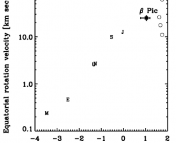Paper Title: Comet-Like Mineralogy of Olivine Crystals in an Extrasolar Proto-Kuiper Belt (arxiv: 1211.2626)
- Authors: B. L. de Vries et al
- First Author’s Affiliation: K. U. Leuven, Flanders, Belgium
- Journal: Nature
Overview
This paper describes observations of the mineral olivine in the famous debris disk surrounding the star Beta Pictoris. Olivine is very important as it is one of the primary building blocks of rocky planets. They find its composition and temperature to match what we find in our outer solar system, hinting that we are spying on a proto-Kuiper belt. The similarity between solar systems suggests similar processes may be operating in other systems as happened here around Sol.
More Detail
In the past decade, we’ve made huge advances in remote characterization of planetary bodies. From the atmospheres of exoplanets to the surfaces of asteroids, astronomers have conducted some pretty extraordinary measurements (for example, the discovery of Alpha Centauri Bb, which entailed measuring the motion of Alpha Cen to 51 cm/s — a slow walk!). However, most of these measurements have been surface measurements. It’s much harder to study the interiors of objects, because we don’t receive photons from them.
There are exceptions, though. Consider a young planetary system with plenty of asteroids. These asteroids will run into each other, shattering apart and generating dust. Light passing through these dust clouds will then have their spectral signature imprinted on them, letting us study their interior composition!
Astronomers have discovered several such systems, allowing us for the first time to characterize the interior composition of rocky bodies remotely. This paper presents the results of the latest such study, on the system Beta Pictoris. Beta Pic hosts a young exoplanet, and its solar system is still in the process of forming — meaning plenty of planetismals to collide and produce dust!
In the course of their Herschel and Spitzer Space Telescope observations, the authors of this paper discovered evidence of the mineral olivine in infrared (IR) spectra. As mentioned previously, olivine is a very important mineral: it is one of the main building blocks of terrestrial planets. Most of the mantle, and hence most of the Earth, is made of olivine. We believe the other rocky planets of the solar system to alse have a lot of olivine. Understanding this building block in other solar systems is very important to understanding rocky exoplanets.
Olivine comes in two flavors: an iron-rich version and a magnesium-rich version. The two mix freely forming a solid solution thanks to the similar valence properties and ionic radius of iron and magnesium. Asteroids close in to the Sun tend to have a lot of iron in their olivine, while comets far out from the sun tend to have much more magnesium.
The authors studied a 69-micron olivine feature (emission at 69 microns due to olivine) that is sensitive to both the composition and temperature of the olivine (see Figure 1). The location and width of this feature is uniquely determined by these two parameters (see Figure 2). In conducting this analysis, the authors found the data to be best matched by temperatures corresponding to distances of 15-45 AU from the star, roughly similar to our own Kuiper belt. We may have obtained a snapshot of a young Kuiper belt!

Figure 1: The 69-micron olivine feature observed by the team. The width and precise location of this feature are dependent on the Fe/Mg ratio and temperature of the olivine.

Figure 2: a map showing how different combinations of 69-micron olivine feature width and location map to different combinations of temperature and composition. The y-axis shows a measure of the width of the feature, while the x-axis shows the central wavelength of the feature -- where exactly it is in wavelength space. The black line is Fe/Mg=0.00, the red is Fe/Mg=0.01, and the green is Fe/Mg=0.02. The blue dot represents the width and central wavelength of the feature observed in Beta Pictoris, corresponding to a temperature of ~85 K and Fe/Mg of 0.01
The authors also found a Fe/Mg ratio of 0.01, indicating that the olive was very Mg-rich – also consistent with what we see from comets and other bodies from the cold outer regions of our solar system. This similarity suggests that similar processes were at work in forming and transporting this mineral in our system and in Beta Pictoris, and hence these processes may be general and not solar-system specific! This is good news for planet formation theories, and bodes well for the possibility of finding a new Earth.




